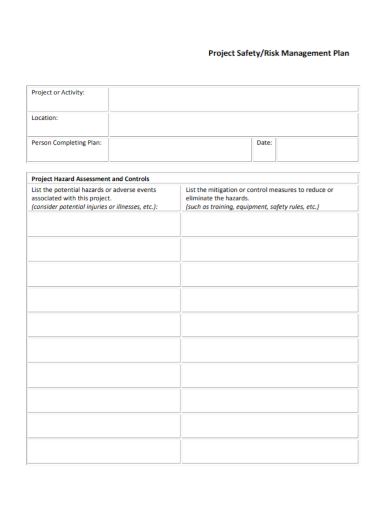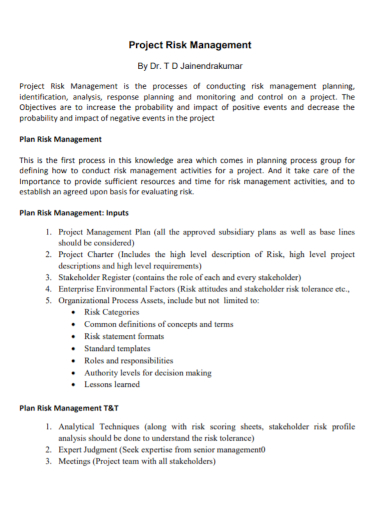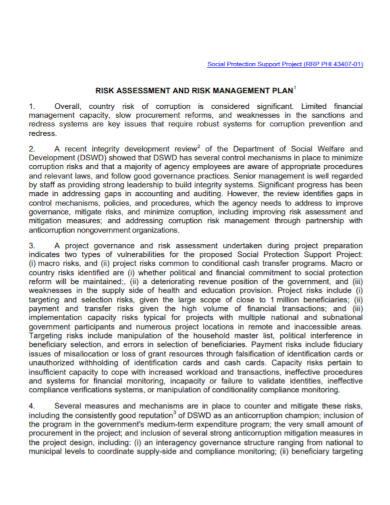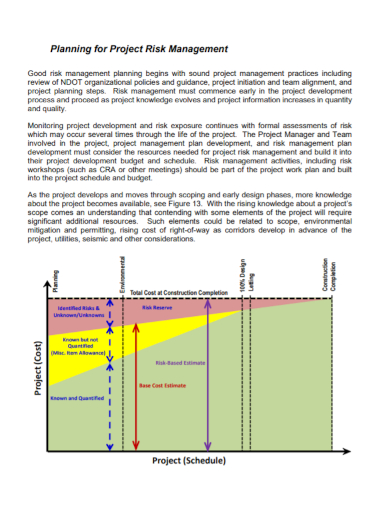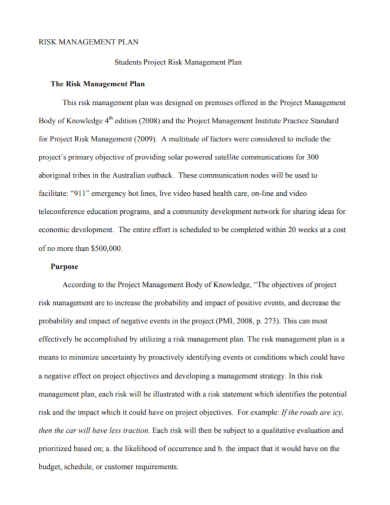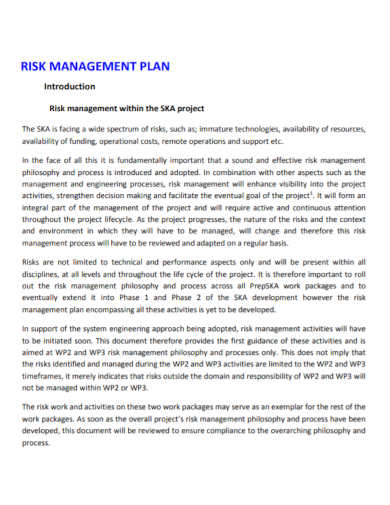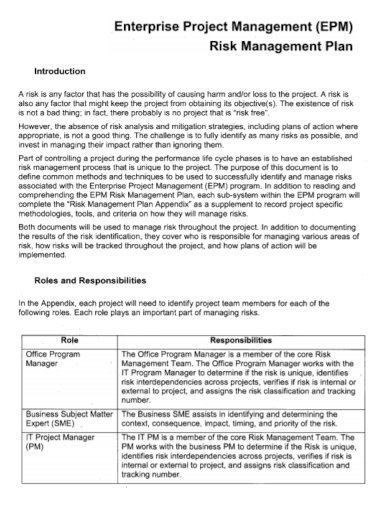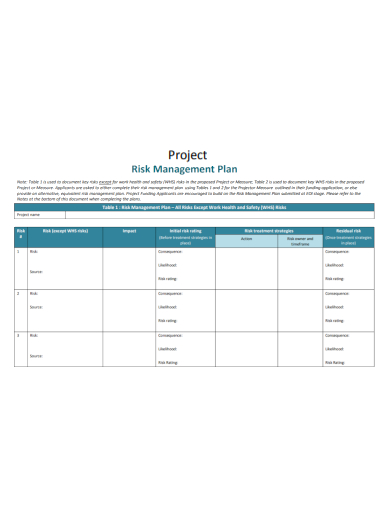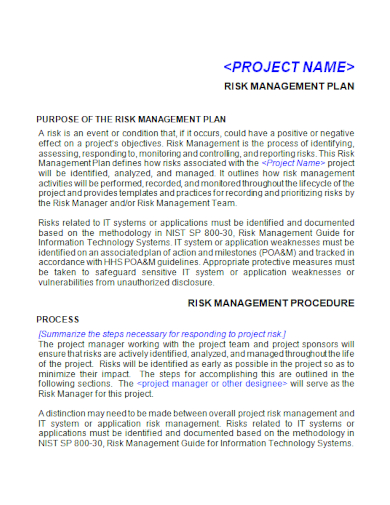We cannot avoid the reality that there is an existing risk managements among projects. Risk managements are designed to help managers in identifying the potential risks before they are going to start doing a specific project. This is to avoid panic especially when a problem or something unexpected will happen. You might ask yourself what about the process of conducting a risk management and what are the activities that can be incorporated into the project management. Risks are managed on a daily basis. Using a systematic risk management, your project can run smoothly and gives a positive impact to everyone involved. The process itself is necessary especially when you are implementing something in your organization. We are not knew to the idea that some risks are bound to become problem areas. However, there are some risks in a given project that you might encounter surprisingly. In this article, you will be able to know more about what a project risk management plan is.
10+ Project Risk Management Plan Samples
1. Project Safety Risk Management Plan
2. Project Risk Management Plan
3. Social Protection Project Risk Management Plan
4. Plan for Project Risk Management
5. Student Project Risk Management Plan
6. Sample Project Risk Management Plan
7. Acquisition Project Risk Management Plan
8. Enterprise Project Risk Management Plan
9. Standard Project Risk Management Plan
10. Project Quality Risk Management Plan
11. Editable Project Risk Management Plan
It is always a good idea to assess whether risk managements are available within an organization. The plan itself should be able to commemorate with how complex your project is. You may also consider about talking to your team and ask them for suggestions about how you could identify and manage the risks properly. Always remember that the quality of your plan does not rely on the physical document. It is through having a proper discussion and interaction with the other team members.
What to Include in a Project Risk Management Plan?
- Project Risk Background – you should be able to describe how you are going to support your organization’s strategic plan. Are the projects you are dealing now riskier than your previous projects? How complex is your project might be? What aspect of the project has the most risk? How many in your team have already experienced managing risks?
- Methodology – provide a description of what method you have used in identifying the risks, assessing the risks, performing the risk planning, and monitoring risks.
- Roles and Responsibilities – consider providing a matrix and list the roles of your project manager, project team, risk owner, stakeholders, and others who will be involved along with their specific tasks and responsibilities.
- Timing – place how often you are performing the risk management activities. Always find time reviewing the risks especially during project meetings. If you have an ongoing project, discuss with your team about the risks.
- Risk Categories – categorize the risks based on their scope, quality, and budget. Companies that usually have a stronger set of risk governance are required to use a standard set of risk categories.
- Definitions – define management terms like risk, risk tolerance, issues, probability, etc.
- Risk attitude, appetite, and tolerance – what could be your management’s response towards the risks that are present in your project? How tolerant is your management?
- Reporting formats – select what type of format you are going to use in reporting the risks including its content.
FAQs
Why is it important to write a risk management plan?
We encounter risks almost everyday in our lives. We cannot be able to predict when it will occur or what exactly will happen. However, using a risk management plan helps us be prepared as possible and keep us calm especially when a risk arises.
What are the elements of risks?
- A risk is an event that may happen.
- The consequence of a risk can be defined by the level of urgency of the impact that it brings to the project area.
- The probability of a risk must be estimated accurately so that your organization can be able to allocate more time and energy to plan, monitor, and respond.
It may take time to create a risk management plan, but this will surely be a good investment to your projects. When you do it properly, you will be saving more time, reduce stress, and even positions your team for your journey to success. Always remember that you should start with a solid foundation to be able to create a well-defined project risk management plan.
Related Posts
FREE 8+ Debt Management Plan Samples in PDF | DOC
FREE 10+ Sales Management Plan Samples in PDF | MS Word | Apple Pages | Google Docs
FREE 4+ 30-60-90-Day Marketing Plan Samples in MS Word | Google Docs | Apple Pages | PDF
FREE 10+ Higher Education Lesson Plan Samples in MS Word | Pages | Google Docs | PDF
FREE 9+ 30-Day Marketing Plan Samples in PDF | MS Word | Apple Pages | Google Docs
FREE 3+ Sales Team Action Plan Samples in PDF | MS Word | Apple Pages | Google Docs
Marketing Plan For Small Business Samples
FREE 7+ Fashion Business Plan Samples in PDF
FREE 10+ Sprint Planning Samples In MS Word | Google Docs | PDF
FREE 10+ Wedding Planning Samples in MS Word | Apple Pages | Powerpoint | PDF
FREE 9+ Monthly Study Planner Samples in PSD | Illustrator | InDesign | PDF
FREE 9+ Sample Curriculum Planning Templates in PDF | MS Word
FREE 10+ Teacher Development Plan Samples in MS Word | Google Docs | Apple Pages | PDF
FREE 10+ Basketball Practice Plan Samples in PDF
FREE 12+ School Business Plan Samples in PDF | MS Word | Apple Pages | Google Docs

